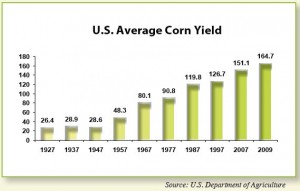Posted By Mark September 27, 2010
So what wine goes best with myths and lies? Apparently someone better figure this out quickly as the American public is getting served up a lot of misleading information and in some cases out right fabrications regarding what they eat. The latest list of food fibs and myths come from the Editors of Eating Healthy Magazine who expose a number of urban food myths including the demonization of High Fructose Corn Syrup (HFCS).
In short, it (HFCS) seems to be no worse—but also no better—than sucrose, or table sugar. “The debate about HFCS and sucrose [table sugar] is taking the focus off the more important question,” says Kimber Stanhope, Ph.D., R.D., a researcher at the University of California, Davis, who has studied the sweetener extensively. “What we should be asking is ‘What are the effects of all sugars (HFCS and sucrose) in the diet?’”
It is interesting to note that High Fructose Corn Syrup (HFCS) is number two on the list of the 13 biggest nutrition and food myths put together by Joyce Hendley, longtime contributing editor at the magazine.
Myth 2: High-Fructose Corn Syrup (HFCS) is worse for you than sugar.
The Truth: The idea that high-fructose corn syrup is any more harmful to your health than sugar is “one of those urban myths that sounds right but is basically wrong,” according to the Center for Science in the Public Interest, a health advocacy group.
The composition of high-fructose corn syrup is almost identical to table sugar or sucrose (55 percent fructose, 45 percent glucose and 50:50, respectively). Calorie-wise, HFCS is a dead ringer for sucrose. Studies show that HFCS and sucrose have very similar effects on blood levels of insulin, glucose, triglycerides and satiety hormones. In short, it seems to be no worse—but also no better—than sucrose, or table sugar.
This controversy, say researchers, is distracting us from the more important issue: we’re eating too much of all sorts of sugars, from HFCS and sucrose to honey and molasses. The American Heart Association recently recommended that women consume no more than 100 calories a day in added sugars [6 teaspoons]; men, 150 calories [9 teaspoons].
The Yahoo-based internet community called Shine takes the Healthy Living list and boils it down to their “six biggest lies” about food and HFCS remains near the top.
The silliness of the HFCS issue is providing some good fodder for hawkers of humor such as Jim Borgman and Jerry Scott, the co-creators of the Zits comic strip. You have to marvel at their ability to send a strong message with a little over 40 words, but in this case one will do - “moderation.”

Posted By Mark September 22, 2010
 During the 2008 food price scare corn found itself squarely in the crosshairs of public indignation. Technically it was the growing use of corn for ethanol fuel that fanned the flames and coined the phrase “food vs. fuel.”
During the 2008 food price scare corn found itself squarely in the crosshairs of public indignation. Technically it was the growing use of corn for ethanol fuel that fanned the flames and coined the phrase “food vs. fuel.”
Then the public ire moved to the soaring cost of petroleum as the true culprit. And that was partially right too. Many experts ultimately said a combination of factors caused the jump in food prices. (Corn prices were near the bottom of the list). Problem was the explanation was months late and the media attention was wimpy at best. Corn and ethanol had been tarred and feathered and the damage done.
The cheap corn mafia led by the Grocery Manufacturers Association eventually confessed, albeit in a whisper, ethanol was one of seven factors having a role in higher food prices. Even the World Bank, the culprit that leaked an erroneous report triggering food vs. fuel, later said “the effect of biofuels on food prices has not been as large as originally thought, but that the use of commodities by financial investors (the so-called “financialization of commodities”) may have been partly responsible for the 2007/08 spike.”
Once again we see corn prices on the rise, topping $5 a bushel last week, and talk about food shortages and skyrocketing grocery bills popping up. This time oil prices are relatively high but stable so what the heck is going on?
Once again probably more than meets the eye but this we do know; the rally has been fueled by USDA forecasts of smaller U.S. corn yields than expected and reports of drought losses in Russia’s wheat crop.
Hafez Ghanem, Assistant Director-General for Economic and Social Development with the United Nation’s Food & Agriculture Organization offers some important perspective: “The market fundamentals are sound and very different from 2007-2008. Despite the shortfall in Russia’s wheat production, this year’s cereal harvest was the third highest on record and stocks are high. Under these conditions we don’t believe that we are headed for a new food crisis, but we will continue monitoring the situation closely.”
Other key points that should help keep irrational fear at bay:
Even if the U.S. corn crop is reduced further we will still be harvesting the 8th record corn crop in the last 8 years. We will have a carryover of ending stocks of 1.1 billion bushels.
World wheat stockpiles are expected to be 174.8 million metric tons in the 2010-11 season, comprised of local marketing years, according to the U.S. Department of Agriculture. That’s 40 percent more than in 2007-08.”
Last month USDA reported food price increases in 2010 would be minimal. The Consumer Price Index for all food increased 1.8% in 2009 and is forecast to increase 0.5 to 1.5% in 2010.
Future prospects for corn supply and ethanol look good. Ethanol production tripled from 2002-2009. During the same time period, corn production met increased demand from ethanol and produced an additional 21% more corn for other needs.
Posted By Mark September 21, 2010
 For years ethanol opponents have beaten on the fuel like a piñata but a funny thing keeps happening…it survives and after each attack the fuel’s reputation grows as does its market.
For years ethanol opponents have beaten on the fuel like a piñata but a funny thing keeps happening…it survives and after each attack the fuel’s reputation grows as does its market.
Ethanol’s reputation grows because the fuel is getting greener. Each new look shows increases in production efficiencies, less water and energy use, more gallons per bushel of corn and even previously estimated projections of greenhouse gasses are proving to be wrong as the science gets better.
A new report out by the US Department of Agriculture today “indicates the net energy gain from converting corn to ethanol is improving in efficiency.
- The net energy balance of corn ethanol has increased from 1.76 BTUs to 2.3 BTUs of required energy.
- Ethanol has transitioned from being an energy sink to a “substantial net energy gain in the present. And there are still prospects for improvement.
- Ethanol yields are up 10% in the last 20 years.
- Corn yields have increased 39% in the last 20 years, requiring less land to produce ethanol.
Titled 2008 Energy Balance for the Corn Ethanol Industry the report surveyed ethanol producers about ethanol yield per bushel of corn and energy used in ethanol plants.
While we are rolling out the good news on ethanol keep these statistics in mind too:
- For the 1st time, DDG availability will displace more than 1 billion bushels of corn in livestock rations this marketing year, providing a high-quality, high-value feed product for livestock producers, both in the US and abroad.
- In the U.S., corn production has more than doubled since 1980, on only 3% more land. That’s an impressive move from 6.6 billion bushels o 13.2 billion bushels, pushed by yields gorwing from 91 bushels an acre to 163.5 bushels per acre today.
Posted By Mark September 20, 2010
“Deepening pain and unrest in Cuba are provoking bold actions that the U.S. government should note,” according to an editorial in the St. Louis Post Dispatch today. After decades of economic stagnation even Fidel Castro recently noted “the Cuban model doesn’t work anymore.”
What spurred Castro’s comment and the editorial is the dramatic change taking place 90 miles from our shore. After decades of economic erosion the worldwide recession is ravaging Cuba, an island nation of 11 million people who largely are dependent on imported food and many other products.
As the editorial points out the Cuban economy has been faltering since the since the Soviet Axis collapsed in 1991 and withdrew its economic support that had become so ingrained in Cuban politics and culture. Cuba lacks a modern manufacturing infrastructure today but what they do seem to have is a growing awareness that they will need to seek foreign investment and outside sources of private capital if they are to bounce back.
The Post rightfully points out the ripe opportunity that presents itself to improve our relationships with one our nearest neighbors. After 58 years of nothing but acid-based rhetoric being the only commodity traversing the Carribean Sea, it is time to regroup and reconsider our relationship with Cuba.
Politics come in many shades and flavors but human nature is not so different. Many Cubans struggle to get enough to eat, so like new neighbors (or at least reformed one’s) let’s reach out with the hand of friendship.
It might produce some positive results, especially if that hand contains the aforementioned food they need. We have the opportunity and the means but do we have the will to do what is right?
Posted By Mark September 16, 2010
 Automotive designers and race car mechanics and engineers from around the world ended their quest to create a 100 + mile-per-gallon vehicle today with an interesting development; the winner was powered by ethanol, E85 to be exact. While many of the competitors chose to pursue the electric-battery option it was corn squeezings that ruled the day.
Automotive designers and race car mechanics and engineers from around the world ended their quest to create a 100 + mile-per-gallon vehicle today with an interesting development; the winner was powered by ethanol, E85 to be exact. While many of the competitors chose to pursue the electric-battery option it was corn squeezings that ruled the day.
However, it is worth noting that the extensive coverage of the $10 million X Prize competition often referred to it as an internal combustion gasoline vehicle. Kudos to the New York Times for getting it right, although I would have liked to have seen E85’s prominent role higher in the story.
Teams from Virginia, North Carolina and Winterthur, Switzerland, with roots in the world of auto racing won the first Progressive Insurance Automotive X-Prize but it was Edison2′s “Very Light Car No. 98” that took the top prize of $5 million.
The media dismissal of the ethanol connection begs the question “when did ethanol become the Rodney Dangerfield of fuel?” We don’t get no respect.” From the Toledo Blade to Wired Magazine online to even autobloggreen , they missed the American fuel angle, the green angle, the tested and proven angle of ethanol made right here, right now. With a host of flexible fuel cars capable of using higher ethanol blends like E85 this deserved to be a key component of the announcement.
Having alternatives to imported petroleum is a great idea because consumer choice (such as the BYO blendyourown initiative) and competition in the marketplace is always a good thing.
On a positive note E85 did win the competition and it offers another example that we don’t lack for solutions to our problems but rather the vision and drive to make them reality.
Posted By Mark September 8, 2010
 Do any other nations contemplate their navels as much as government and business in America? I know of nowhere else on the planet where people will spend precious time and millions of dollars to do studies related to previous studies. If it does exist, I don’t think I want to move there.
Do any other nations contemplate their navels as much as government and business in America? I know of nowhere else on the planet where people will spend precious time and millions of dollars to do studies related to previous studies. If it does exist, I don’t think I want to move there.
With that observation aside…on to the latest study on Hypoxia and this one happens to be serious in nature, better than many and related to an issue we must understand better. Hypoxic Zones - a condition in which oxygen levels drop so low that fish and other animals are stressed or killed - are often better known in the environmental community and mass media by the stage name of “Dead Zones” for its shock value.
What makes the latest look at Hypoxia interesting is the diverse list of folks involved in the study and several very public observations that would seems to show the wisdom of what many experts have said for years; hypoxia is real, a growing risk, and complex to the point of still largely evading current science.
The study compiled by the National Oceanic and Atmospheric Administration had significant inputs from the Environmental Protection Agency, the Department of Agriculture, the U.S. Geological Survey, and the Virginia Institute of Marine Science. It shows a growing body of thought that climate change is a big factor in these zones, urban contributions are significant and most of the zones are in places with little intensive farming or fertilizer use.
The study provides a comprehensive list of the more than 300 U.S. coastal water bodies affected by hypoxia. This alone is interesting. Much of what the public has heard about hypoxia in the past is related to the dead zone in the Gulf of Mexico and the finger pointers saying agriculture, and specifically growing corn production and fertilizer use, is the culprit. This continues despite static acreage, better soil and water management, and reduced fertilizer use.
The new report at least points out nutrient delivery to coastal waters throughout the nation come from urban and suburban landscapes (golf courses & your lawn), city water treatment sewage discharges and even air pollution. The non-Ag sources get a serious look in this study - and they should - given most of the 300 affected waterways have little corn production or intensive use of commercial fertilizers in agriculture.
“This report makes it clear that there are many causes of hypoxia and that the causes vary based on location of the affected areas. Some are agriculture-related, and many are not. We support further research into all the causes of hypoxia because only then can we seriously develop and implement solutions that are workable and sustainable,” said Darrin Ihnen, National Corn Growers Association president of South Dakota.
One big red flag is the largest and fastest growing zones are in the Pacific Northwest which they are attributing to an emerging link to changing climate. Despite this revelation and better balance than many hypoxia papers, this one still singles our corn and growing demand for ethanol as a key culprit.
The study mentions increased corn acreage from 2006 to 2007 but does not mention the acreage drop from 2007 to 2008, and that the acreage planted in 2010 is more than 5 million acres fewer than in 2007.
The hit on corn overshadows the more interesting findings of the geographic diversity of these zones and the emerging link to climate change. These zones have increased 30-fold since 1960 despite advances in agricultural technology and have been located in many areas of the world where no fertilizer is used. Hopefully, this study will broaden the debate and open some minds on the hypoxia issue.
Posted By Ken August 31, 2010
 As a more upbeat follow-up to our last discussion of ethanol in the Golden State, there is this news item about how ethanol and biodiesel availability is expanding in California.
As a more upbeat follow-up to our last discussion of ethanol in the Golden State, there is this news item about how ethanol and biodiesel availability is expanding in California.
OAKLAND, CA-(Marketwire - August 31, 2010) - At a grand opening event today at the Bay Area’s newest renewable fuel station, California Energy Commissioner Anthony Eggert, Director of California Governor Schwarzenegger’s Office of Economic Development (GoED) Joel Ayala, and officials from Propel Fuels, CALSTART, and East Bay Clean Cities, formally launched Propel’s Bay Area operations, which will include more than 20 stations across the Bay, with up to 10 open by the year’s end. The event also announced a $10.9 million grant from the U.S. Department of Energy (DOE) and California Energy Commission (CEC) to build and operate 75 retail renewable fuel stations throughout California over the next two years.
More information on Propel can be found here.
Posted By Mark August 24, 2010
This week we are supposed to be afraid of eating eggs. Apparently we have about a 1 in 20,000 chance of getting salmonella from eating eggs. The odds are slightly higher that you will die in a fall this year. I will take those odds and so would Vegas.
Interestingly enough I celebrated the big egg scare by whipping up a wonderful spinach quiche and an omelet the next day. I wish I could say I am really that sarcastic and warped, but I really already bought the stuff and had a hankering for eggs.
Eggs are a great tasting, inexpensive source of protein that are fast and easy to cook so I wasn’t real big on letting fear overpower good judgment or my taste buds. As with many food scares a little common sense goes a long ways toward keeping you safe, healthy and well fed.
Food related illnesses in the U.S. are actually pretty rare considering the size of our population and the amount of food we consume at home, at work, at play and on the run.
If an egg containing Salmonella has been kept refrigerated and someone who uses good hygiene practices serves it to you immediately after proper cooking, you’ll simply have a nutritious meal. If the egg has been improperly handled, though, you might experience the foodborne illness
Posted By Mark August 12, 2010
 Ok, anyone besides me get a little irked when the Chicago Board of Trade and others read the USDA crop report like it was from Moses coming down the mountain? If people could predict crops with high levels of accuracy the board of trade would be a ghost town.
Ok, anyone besides me get a little irked when the Chicago Board of Trade and others read the USDA crop report like it was from Moses coming down the mountain? If people could predict crops with high levels of accuracy the board of trade would be a ghost town.
The traders and speculators would cash in, check out, and be sipping umbrella drinks in Tahiti.
Today’s crop report triggered all kinds of news stories and messaging in social media that all read like the crop of 2010 was in the bin. Just a note for future reference a corn crop isn’t made in June, July or even August. It is cumulative.
Corn production is forecast at a record high 13.4 billion bushels, up 2 percent from the previous record set in 2009. Based on conditions as of August 1, yields are expected to average a record high 165.0 bushels per acre, up 0.3 bushel from last year’s record of 164.7.
However every stage from planting to ear set to pollination is critical. And so is ear filling. August is traditionally the time when a crop is polished off…the shine is put on the apple so to speak. The size of the ears is already determined but the final yield depends on the number of kernels developed and its weight and size. The size of the kernel is still on the bubble for the 2010 crop in many areas.
For much of this key kernel filling stage many key corn production states have been experiencing severe heat and in some cases accompanying dry conditions.
Then why have we been doing these reports since 1863? Apparently President Abraham Lincoln was swayed by USDA’s contention (actually included in the first report) that “Ignorance of the state of our crops invariably leads to speculation in which the farmer does not obtain just prices and by which the consumer is not benefitted.”
It is hard to argue with that. I prefer to think of the report as a compass that helps point the way but you may be stopping to ask for directions before you reach your final destination.
At the end of the day the news is good. We will once again be blessed with an abundant harvest and it appears prices will be good enough to pay the bills and sustain family farmers for another year.
Posted By Mark August 9, 2010
Every so often you come across a single well turned phrase that you wish had come out of your own mouth. I did so this morning while checking out a blog in the Los Angeles Times regarding the latest over-blown information purporting links between fructose sweetener and cancer.
Tami Dennis, health and science editor of the Los Angeles Times wrote the article about the recent UCLA study linking HFCS to the spread of pancreatic cancer contending that it could be an “overstatement.”
But the best line from the piece is a cutline under a lab photo accompanying her blog which said: “The road between a lab experiment and public policy is long. Or it should be.”
Wow! Words to live by. The UCLA hype is just the latest effort to take a free-standing nugget of information and attempt to pawn it off as scientific gospel akin to Galileo’s observation that gravity works.
Dennis cites the blog Respectful Insolence in her argument. “I hate science press releases that hype a study beyond its importance. I hate it even more when the investigators who published the study make statements not justified by the study and use the study as a jumping off point to speculate wildly.”
She is right on in her assessment. However, the problem is the UCLA news release got huge national exposure, fructose got another undeserved whack, and a small percentage of people who read the original news story will ever see the much lower profile condemnations of this shoddy approach to research.
Gilbert Ross, M.D., Executive Director and Medical Director of the American Council on Science and Health had a similar reaction to the UCLA gambit saying, “Both the authors and the press need to retract these alarmist and unsupported claims — especially the authors, since such gross over-interpretation of a lab study is inexcusable among academic scientists. They seem to be grasping for headlines and promoting some anti-fructose political agenda.”
For more background on this issue you might want to check out a much more thoughtful piece here.
Page 3 of 16«12345»10...Last »







 As a more upbeat follow-up to
As a more upbeat follow-up to 